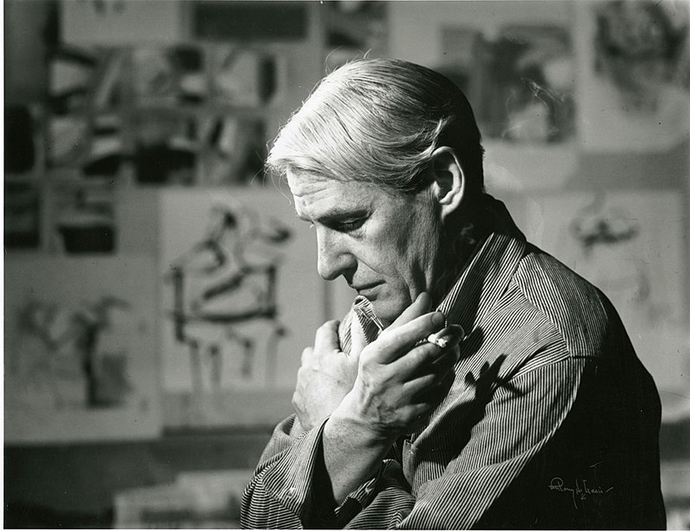
Willem de Kooning
Willem de Kooning was a Dutch-American abstract expressionist painter renowned for his innovative and emotive works that played a pivotal role in shaping the mid-20th-century art scene. His diverse artistic journey encompassed striking shifts in style, ranging from abstract explorations to his iconic "Woman" series.
His artwork was showcased at various esteemed venues, including the Egan Gallery, the Sidney Janis Gallery, the Museum of Fine Arts in Boston, the Arts Club of Chicago, the Martha Jackson Gallery, the Workshop Center, the Paul Kantor Gallery, the Hames Goodman Gallery, the Allan Stone Gallery, and the Smith College Museum of Art.
Biography of Willem de Kooning
Willem de Kooning was born in 1904 in Rotterdam, Netherlands. Departing from formal education in 1916, he embarked on an apprenticeship with a commercial art firm. Until 1924, he attended evening courses at the Academie van Beeldende Kunsten en Technische Wetenschappen (Academy of Fine Arts and Applied Sciences) in Rotterdam.
In 1926, de Kooning made his way to the United States. He stayed at the Dutch Seamen's Home in Hoboken, New Jersey, and secured employment as a residential painter. He obtained American citizenship in 1962.
In 1927, he relocated to Manhattan, establishing his studio on West Forty-fourth Street.
By 1928, he had become a part of the art community in Woodstock, New York, while simultaneously establishing connections with modernist artists in Manhattan. Notably, he crossed paths with figures such as Stuart Davis, Arshile Gorky, and John Graham.
In 1934, de Kooning became a member of the Artists Union. The following year, in 1935, he became associated with the Federal Art Project of the Works Progress Administration. Within this project, he undertook the creation of several murals.
Starting in 1937, he began working as a full-time artist, generating income through commissions and teaching engagements. In 1943, he married the painter Elaine Fried. During this period, De Kooning initiated his first series of portrait paintings, depicting figures like standing or seated men in works such as "Two Men Standing," "Man," and "Seated Figure (Classic Male)."
During that period, De Kooning's artistic output drew significant inspiration from Gorky's surrealist visual language and reflected the influence of Picasso.
In the late 1940s and early 1950s, de Kooning aligned himself with fellow contemporary artists like Jackson Pollock and Franz Kline. Together, they endeavored to liberate their art from prevailing artistic currents of the time, such as Cubism, Surrealism, and Regionalism.
He was a member of an artistic collective known as the New York School. This group included fellow painters like Jackson Pollock, Elaine de Kooning, Lee Krasner, Franz Kline, Arshile Gorky, Mark Rothko, Hans Hofmann, John Ferren, Nell Blaine, Adolph Gottlieb, Anne Ryan, Robert Motherwell, Philip Guston, Clyfford Still, and Richard Pousette-Dart.
In 1948, he held his inaugural solo exhibition at the Charles Egan Gallery, predominantly showcasing black-and-white pieces, although a handful featured segments of vibrant color.
During the latter part of the 1950s, de Kooning began to exhibit a growing fascination with abstract and less figuratively bound imagery.
In 1963, he moved from Broadway to a modest residence in East Hampton. He built a studio nearby and lived in this house until his passing.
In 1989, De Kooning was honored with the Praemium Imperiale prize for painting by the Japan Art Association.
De Kooning completed his last artworks in 1991 and passed away in 1997 at the age of 92.
Willem de Kooning's Paintings
During the 1930s and early 1940s, De Kooning's works were characterized by abstract still-life compositions distinguished by geometric or biomorphic forms and vivid hues. Simultaneously, he created a series of solitary male figures portrayed in standing or seated poses against indistinct backdrops.
In 1946, facing financial constraints that hindered his ability to acquire traditional artists' pigments, he started using black and white household enamels to create a series of expansive abstract artworks. De Kooning's black paintings hold significance within the history of abstract expressionism due to their densely layered forms, incorporation of mixed media, and unique technique.
In 1950, he embarked on an intensive exploration of the female subject. This marked the beginning of his renowned Woman series, which started in 1950 and reached its zenith with Woman VI.
Years:
Born in 1904
Country:
Netherlands, Rotterdam
Gallery: